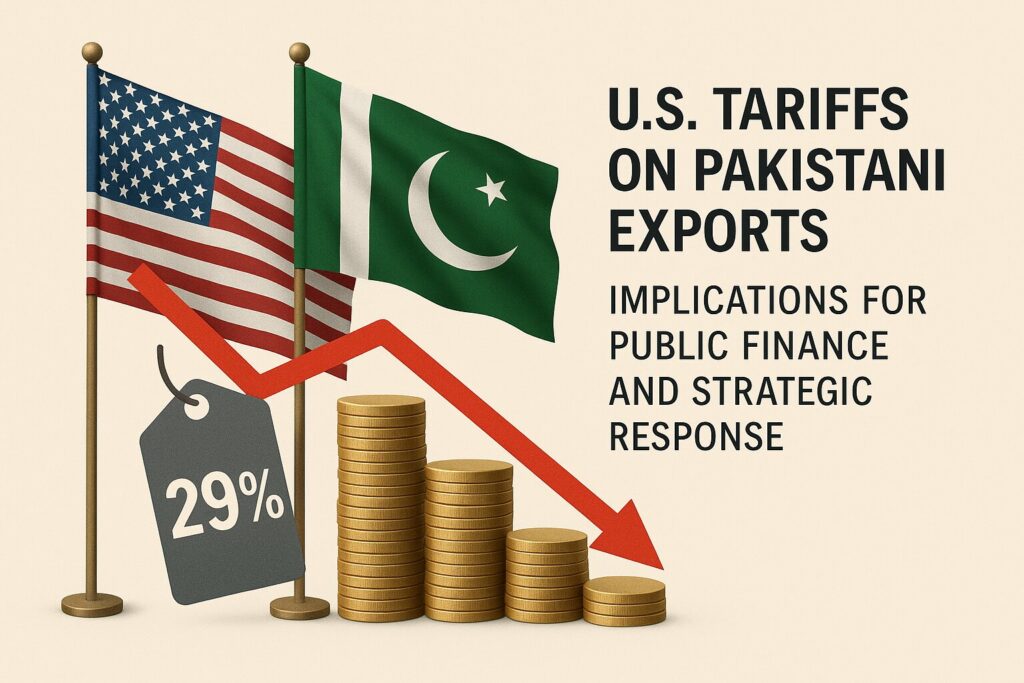
In April 2025, the United States imposed a 29% reciprocal tariff on Pakistani exports, augmenting the existing 8.6% Most Favored Nation (MFN) duty to a cumulative 37.6%. This policy shift, part of President Donald Trump’s broader “Liberation Day” tariff initiative, poses significant challenges to Pakistan’s export-driven economy, particularly affecting its public finance landscape.
Economic Impact Assessment
The United States stands as Pakistan’s largest single-country export destination. In the fiscal year 2024, Pakistan’s exports to the U.S. amounted to $5.3 billion, with textiles and apparel comprising approximately 79% of this trade. The newly imposed tariffs threaten to reduce Pakistan’s exports to the U.S. by 20–25%, translating to an annual loss between $1.1 billion and $1.4 billion. This decline not only jeopardizes foreign exchange earnings but also risks approximately 500,000 jobs within the export sector, predominantly in textiles.
Public Finance Repercussions
The anticipated reduction in export revenues is poised to exert pressure on Pakistan’s public finances. A decrease in foreign exchange inflows may lead to a depreciation of the Pakistani rupee, escalating the cost of imports and potentially widening the current account deficit. Furthermore, diminished export earnings could result in lower tax revenues from export-oriented industries, challenging the government’s fiscal consolidation efforts. These dynamics may complicate Pakistan’s engagements with international financial institutions, such as the International Monetary Fund (IMF), especially concerning ongoing and future bailout programs.
Comparative Tariff Landscape
While Pakistan faces a 29% tariff, other regional competitors are subject to varying rates: Bangladesh at 37%, Vietnam at 46%, and India at 26%. This differential presents a nuanced competitive environment. Although Pakistan’s tariff rate is lower than some, the country’s heavy reliance on textile exports to the U.S. market amplifies its vulnerability.
Strategic Policy Recommendations
To mitigate the adverse effects of the U.S. tariffs, Pakistan may consider the following strategies:
- Export Diversification: Reducing dependence on the U.S. market by exploring alternative destinations, such as the European Union, Middle Eastern countries, and regional partners within the South Asian Association for Regional Cooperation (SAARC).
- Value Addition: Investing in the development of high-value products within the textile sector to enhance competitiveness and reduce susceptibility to price-based market shifts.
- Trade Negotiations: Engaging in diplomatic dialogues with U.S. counterparts to seek tariff relief or exemptions, emphasizing mutual economic benefits and the potential for trade balance improvements.
- Domestic Policy Reforms: Implementing policies that support export-oriented industries, including tax incentives, infrastructure development, and capacity-building programs to enhance productivity and compliance with international standards.
The imposition of a 29% tariff by the United States on Pakistani exports presents a multifaceted challenge, impacting trade volumes, employment, and public finances. However, it also serves as a catalyst for Pakistan to reassess and reform its trade policies, diversify its export base, and strengthen economic resilience. Proactive measures and strategic planning are imperative to navigate this complex trade environment and safeguard Pakistan’s economic interests.
This Article was published on www.publicfinance.pk.
